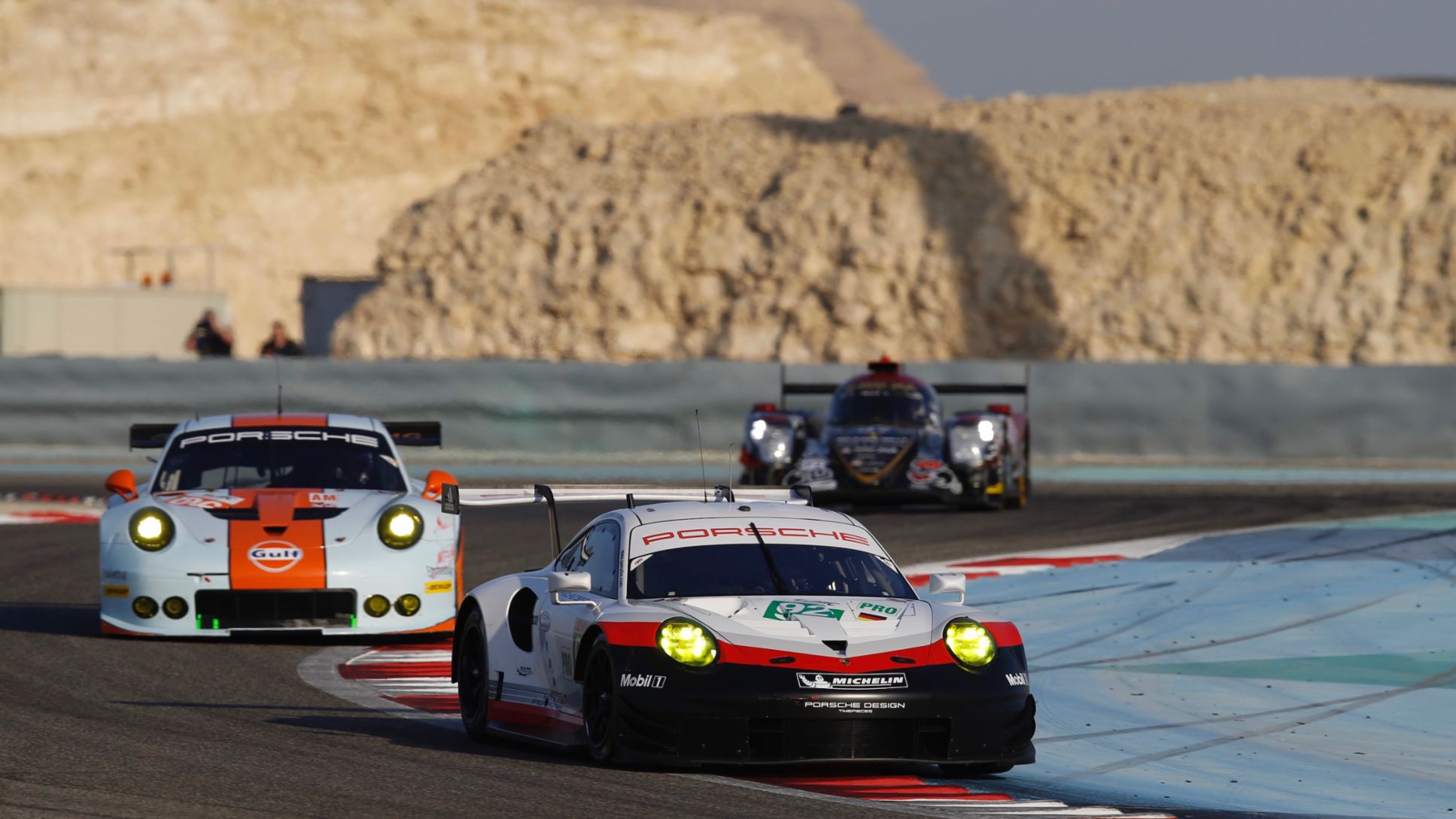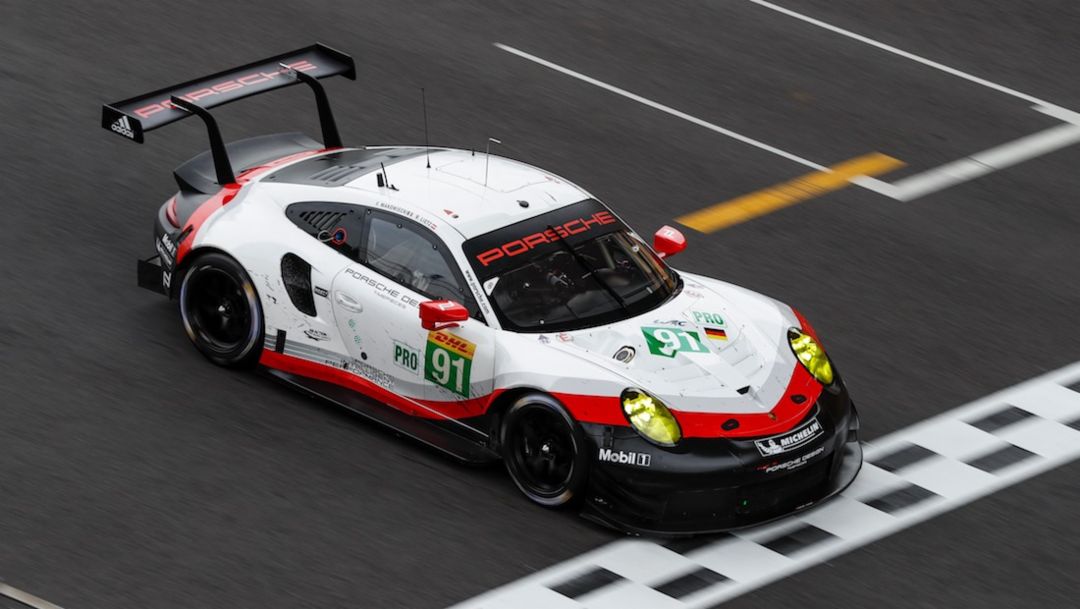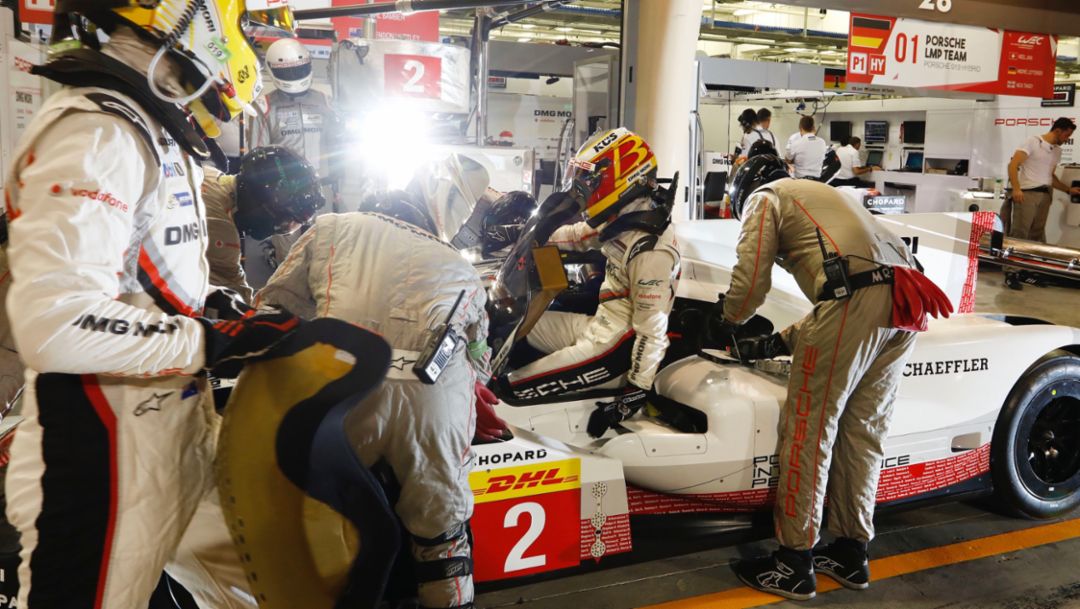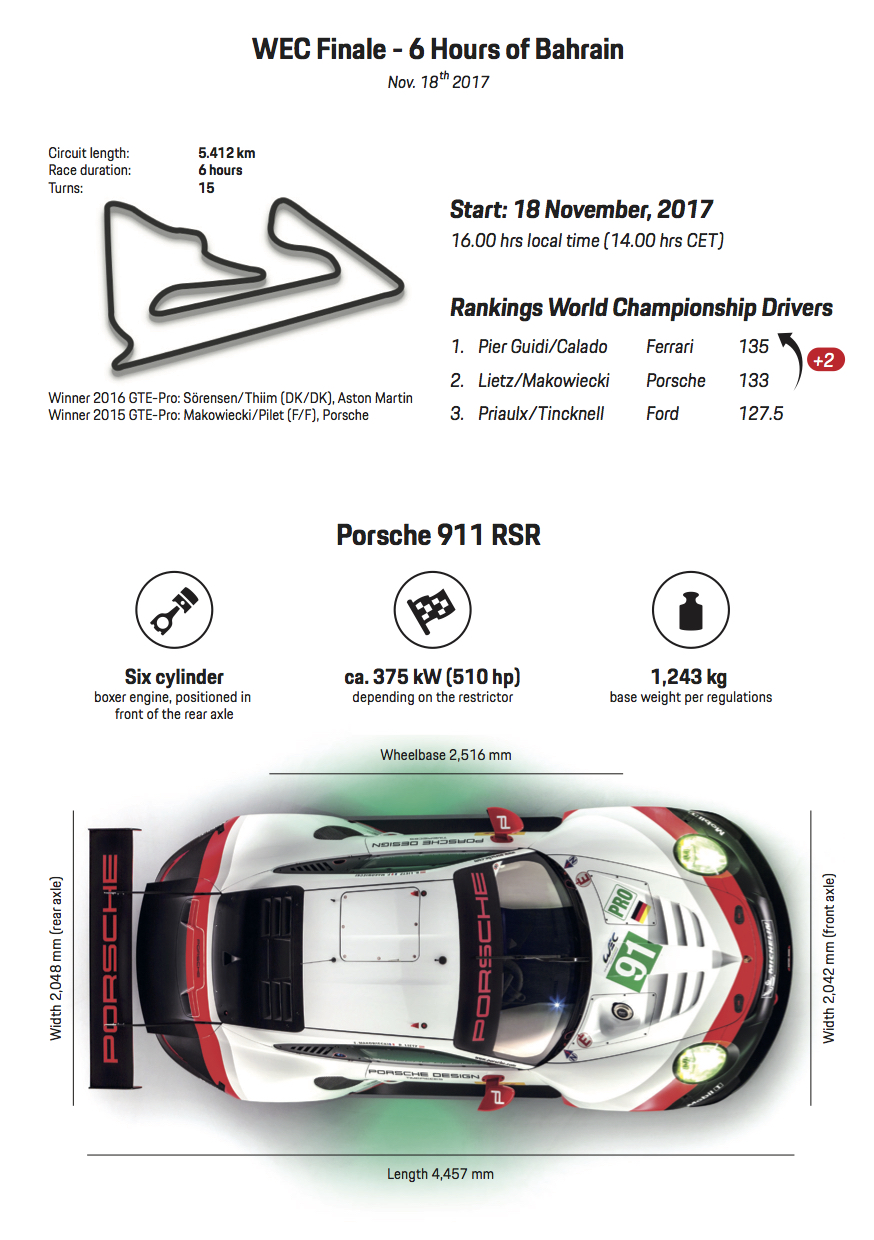GT-Team
Richard Lietz (Austria) and Frédéric Makowiecki (France) aim to wrap up an incredibly close and eventful season by securing the GT drivers’ title with the Porsche 911 RSR. Their prospects of claiming the crown in the first season of the newly developed race car from Weissach look good: Ranking second in the drivers’ classification, they are just two points behind the leaders and could take home the world championship crown by their own efforts. Also within reach of a world championship title is the Porsche GT Team, which currently lies second in the team classification. In Bahrain, the Porsche GT Team fields two 911 RSR in the fiercely competitive GTE-Pro class. Their toughest rivals in the fight for the world championship are Ferrari and Ford. Dempsey Proton Racing travels to the Kingdom at the Persian Gulf also holds title chances: The Porsche customer team is within striking distance of clinching the FIA World Endurance Trophy in the GTE-Am class with a 911 RSR.
The Porsche drivers
In Bahrain, four Porsche factory pilots and a Porsche Young Professional contest this season’s last WEC round. Richard Lietz (Austria) and Frédéric Makowiecki (France) share the cockpit of the #91 Porsche 911 RSR. Their team colleagues Michael Christensen (Denmark) and Kévin Estre (France) drive the 911 RSR with the starting number 92. In the GTE-Am class, Porsche customer teams field two 2015-spec 911 RSR: Dempsey Proton Racing has notched up two victories at the Nürburgring and in Mexiko so far this season with the Porsche Young Professional Matteo Cairoli (Italy), Christian Ried and Marvin Dienst (both Germany). Ben Barker and Michael Wainwright from Great Britain as well as Australian Nick Foster compete in the 911 RSR run by Gulf Racing.
Comments before the race
Dr. Frank-Steffen Walliser, Vice President Motorsport and GT Cars: “In Bahrain, an exciting WEC season comes to an end, the first for our new 911 RSR. Considering how close and fierce the competition in the GT categories were this year, it’s no surprise really that most of the title decisions have to wait until the finale. Our very clear focus for the final round is to provide Richard Lietz and Frédéric Makowiecki with all the support they need to win the race and secure the world championship title, which is awarded this year for the very first time in the GTE-Pro class. The first WEC win for the 911 RSR would also increase the chances for the Porsche GT Team to win the team classification. And, of course, we’re keeping our fingers crossed for our Dempsey Proton Racing customer team, who still has a chance to conclude a successful season by winning the FIA World Endurance Trophy.”
Marco Ujhasi, Director GT Factory Motorsports: “Racing in the heat of Bahrain is the ultimate test for the brakes. Those who have the right knack and manage to cope with the temperatures enjoy a huge advantage and have the best chances to be amongst the frontrunners. And the season finale in the desert also puts the tyres under incredible stress. However, as we’ve seen in the last few years, the brakes are the decisive factor.”
Drivers' quotes in the press release (see downloads).
LMP-Team
One of the most successful chapters in Porsche’s motorsport history comes to an end next Saturday: The first test version of the Class 1 Le Mans prototype was rolled out by an entirely new team at Porsche’s research and development center in Weissach back in 2013. The 919 Hybrid's power train concept was as innovative as it was brave, consisting of the most efficient combustion engine Porsche had ever built combined with two different energy recovery systems. Despite a difficult test period, 2014 saw the first positive results: four pole positions and the first race win. Since 2015 to date, the Porsche LMP Team has been phenomenally successful: three consecutive Le Mans outright victories plus three successive manufacturers’ world championship titles while Porsche 919 Hybrid drivers have won the drivers’ world championship title on three occasions.
When Porsche entered the LMP1 category for the 2014 season, this happened in the footsteps of Ferry Porsche’s philosophy, who established motorsport as the ultimate challenge and development cycle. The 2014 LMP1 technical regulations presented a tremendous challenge: It required hybrid technology from manufacturers and at the same time, penalized a high amount of recovered energy by limiting the fuel consumption; on top of that it left huge individual freedom on how to deal with these complex requirements. The Porsche engineers didn’t focus on existing race cars but made full use of the chance to create a revolutionary race car from scratch.
The free practice
In the first two free practice sessions for the last round of the 2017 FIA World Endurance Championship Neel Jani (CH), André Lotterer (DE) and Nick Tandy (GB) came third and fourth respectively. The new world champions, Earl Bamber (NZ), Timo Bernhard (DE) and Brendon Hartley (NZ), finished in the same positions but in reverse order. Hartley clocked today’s fastest lap for the
Porsche 919 Hybrid in 1:40.773 minutes. Two Toyotas topped the time sheets.
Saturday’s six-hour race at the 5.41 kilometre long Grand Prix circuit in the Kingdom’s desert will mark the end of an era. After three outright victories at the Le Mans 24-Hours and winning the world championships for drivers as well as for manufacturers in 2015, 2016 and 2017, Porsche pulls out of the Le Mans Prototype category. For its final race, the exceptionally successful race car has got a special livery: the red stripe carries the names of all the people that have contributed to this chapter of Porsche’s motorsport history. Furthermore, the fin indicates the #919tribute social media campaign. The nicest farewell wishes from Facebook, Instagram and Twitter that use the hashtag will be published on the official Porsche homepage and in the LED strip light at the Porsche Museum in Zuffenhausen.
The first practice session was interrupted for 37 minutes due to circuit repairs and cleaning. Later the 919 Hybrid of Jani/Lotterer/Tandy had to pit for quick repairs after a shortcut in a loom required fixing. The second 90-minute session took place entirely in darkness in pleasant ambient temperatures of around 25 degrees Celsius. Shortly before the end of FP2, Bamber touched a LMP2 car but was able to drive back to the pits.
In its final six-hour race, the Porsche 919 Hybrid will once again drive from daylight into the night on Saturday, November 18, in Bahrain. The race will start at 16:00 hrs local time (14:00 CET), sun set is at 16:46 hrs. Unlike at Le Mans, the drivers don’t race only in the tunnel view of the car’s headlights. 5,000 floodlights illuminate the Formula One circuit which allows for worldwide online and TV coverage until the chequered flag.
The qualifying session for the Le Mans prototypes on Friday from 17:30 to 17:50 hrs local time also takes place in the dark.
The Porsche LMP Team after practice
Fritz Enzinger, Vice President LMP1: “Back then we developed from zero a highly complex hybrid race car on a Formula One level. The early days were extremely demanding, especially as we had to set up the infrastructure, including new buildings, at the same time, plus assembling a team of 260 excellent people. The timing was really tight and the 2014 Le Mans race came way too early for us. But since then, we have managed maximum success. I’m incredibly proud of this team and I hope that we can conclude the era of the Porsche 919 Hybrid with a good race in Bahrain.”
Team Principal Andreas Seidl: “All in all it was a good first day for us. We managed to test all the set-up options we wanted to and tried the different tyre compounds on longer runs. We are not entirely happy yet with the cars’ balance and performance and want to try and make a step forward for tomorrow. In the first free practice session, we lost about 15 minutes with car number 1 when we had to fix a loom.”
The drivers' quotes in the press release (see downloads).
Cars
The Porsche 911 RSR
The 911 RSR, developed on the basis of the high-performance 911 GT3 RS sports car, contested its first season in 2017. The suspension, body structure, aerodynamic concept, engine and transmission were all designed from scratch by Porsche Motorsport in Weissach for this season. Depending on the size of the restrictor, the motor, which is positioned in front of the rear axle, puts out around 375 kW (510 hp). Thanks to the large rear diffuser combined with a top-mounted rear wing, the level of downforce and the aerodynamic efficiency were significantly improved. It scored its maiden victory at the American IMSA SportsCar Championship race at Lime Rock on 22 July. The best results so far in this year’s Sports Car World Endurance Championship WEC were second place at the rounds in Nürburgring, Austin, Fuji, and most recently at Shanghai.
The Porsche 919 Hybrid
The Porsche 919 Hybrid develops a system power of around 900 HP (662 kW) that comes from a compact two-litre turbo charged V4-cylinder (nearly 500 HP/368 kW) engine and two different energy recovery systems – brake energy from the front axle combined with exhaust energy. The combustion engine drives the rear axle while the electro motor boosts the front axle with an output of more than 400 HP (294 kW). This way the 919 accelerates with four-wheel drive and at the same time recuperates energy again from the exhaust system that otherwise would pass unused in to the atmosphere. The electrical energy that comes from the front brakes and the exhaust system is temporarily stored in a liquid-cooled lithium ion battery. Money can’t buy what Porsche has learnt from the 919 program for future road going hybrid and electric cars. Dimensions unknown before were discovered in, for example, the areas of combustion efficiency, battery and high voltage technology as well as energy recovery.
Balance of Performance (BoP)
The “Balance of Performance” applies to the GTE-Pro class of the WEC Sports Car World Endurance Championship as well as the GTLM class of the IMSA SportsCar Championship. “BoP” was introduced by the FIA with the aim of achieving a level playing field for the different vehicle concepts, and thus ensuring balanced and fair races. The intention is that it should not make a fundamental difference if a vehicle is powered by a turbocharged or normally aspirated engine, or if the engine is mounted on the front axle or in front of the rear axle. The basic aerodynamic shape of the vehicles should also not play a decisive role.
After an initial grading by the FIA, the balance of performance is adjusted at the races by means of telemetry - not only using lap times, but also acceleration profiles and engine mappings. This data input is automatically analysed and incorporated into the “Balance of Performance”. The most frequently used means of adjusting the performance level is through adding or subtracting weight. In keeping with the rule-makers’ intention, the key to success on the racetrack is not about the individual potential of a vehicle, instead it’s about the performance of the drivers, the race strategy, a perfect setup or the skill of the team with their pit stops.
The race
A distinctive feature of the six-hour race on the Bahrain International Circuit is that it starts in the heat of the afternoon and ends in the darkness and cooler temperatures of the late evening. The 5.407-kilometre racetrack with its 14 corners is located 30 minutes by car to the southwest of the capital Manama. In 2004, the track was purpose-built in the middle of the desert for Formula 1.
Schedule
Local time:
Thursday, November 16 2017
15:00-16:30 hrs 1st free practice
19:30-21:00 hrs 2nd free practice
Friday, November 17 2017
11:20-12:20 hrs 3rd free practice
17:30-17:50 hrs Qualifying LMP1 & LMP2
Saturday, November 18 2017
16:00-22:00 hrs Race
TV and live streaming
The official WEC App can be downloaded free of charge with an extended (not free of charge) version available which includes full live streaming and full timing. The live stream is voiced by the FIA WEC TV team including live interviews from the pits.
The WEC races can be followed on various international TV channels in Europe, Asia, Australia and New Zealand, North and South America as well as in the Middle East and Africa.
Facts and figures
The WEC efficiency regulations limit the amount of energy that can be used per lap. On the 5.41 kilometres long lap of the Bahrain International Circuit, the Porsche 919 Hybrid can use 4.92 megajoule of electrical power from energy recovery systems and 1.907 litres/1.381 kg litres of petrol.
At normal race speed, the 919 Hybrid is due for refuelling after 31 laps.
Refuelling and changing tyres may only be done sequentially, not at the same time. Only four mechanics may work simultaneously when changing tyres and also may use only one wheel gun at a time. That takes a lot longer than in F1, for example.
The drivers are normally only changed when new tyres are needed.
These different types of tyres can be used: three different compounds of slick tyres for dry conditions, a hybrid tyre (no profile either but softer cover) for mixed conditions and wet weather tyres. Four sets of dry weather tyres are available per car for qualifying and the race, this is two sets less than in 2016.
A lap on the F1 track of the Bahrain International Circuit has nine right-handers and six left-handers. The longest straight is at the start-finish and measures 1.090 kilometres.
The circuit opened in 2004 and is located about 30 kilometres outside Bahrain’s capital of Manama. Over 30 islands in the Persian Gulf belong to the Kingdom. Its size is around 750 square kilometres and has a population of almost 1.5 million.
The Sports Car World Endurance Championship WEC
Sports prototypes and GT vehicles contest the Sports Car World Endurance Championship (WEC) in four classes: LMP1 (eg. Porsche 919 Hybrid), LMP2, LMGTE-Pro (eg. 911 RSR) and LMGTE-Am (eg. 911 RSR model year 2015). They all compete together in one race but are classified separately.
Info
All scores: http://www.fiawec.com/en/season/result
All results: http://fiawec.alkamelsystems.com
Consumption data
911 GT3 RS: Fuel consumption combined 12.7 l/100 km; CO2 emissions 296 g/km




